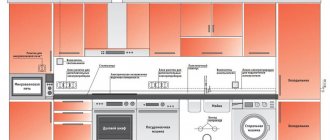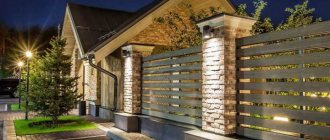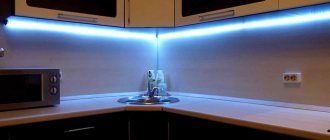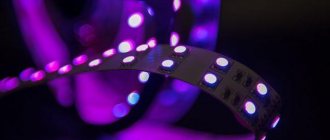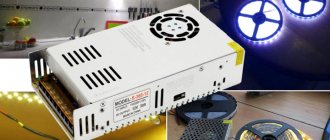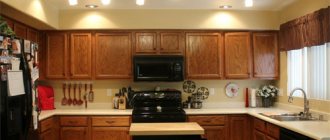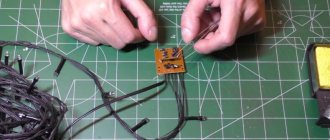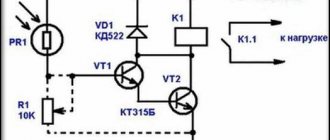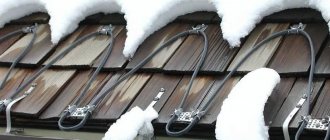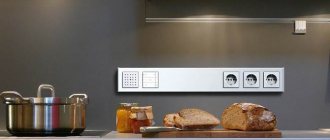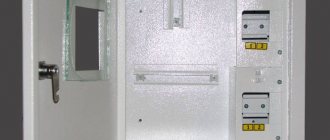/Accessories and decor/Lighting/
Proper lighting is one of the components of the effective design of any room. It is especially important in the kitchen, where the correct distribution of light flux turns cooking into a pleasant and comfortable process. All you need for this is a lighting design and calculation. One of the most interesting options in modern interiors, which you can implement with your own hands, is LED strip lighting.
LEDs are special semiconductors that emit light when electrical energy passes through them. LEDs can have different chemical compositions, which causes the brightness of the light they generate to differ. There is one more nuance - the installation of LED backlighting is never carried out directly, since this way the tape can overheat and break. A prerequisite for connecting LEDs is the presence of a stabilizer.
Advantages of LED lighting
LED lighting has a number of obvious advantages:
- Resistance to mechanical external damage;
- Durability – kitchen lighting strip can last 14 years or more even when working more than 15 hours a day;
- A variety of colors - kitchen lighting under cabinets can be made in white, red and orange, green and blue, purple and yellow. You can also choose LEDs that operate in the infrared and ultraviolet spectrum;
- Excellent lighting brightness, and the device does not require time to warm up;
- Affordability (due to distribution and popularization);
- Possibility to use tape with different radiation angles;
- Safety;
- Environmental friendliness;
- Undemanding to room temperature.
Linear type backlight
Linear lighting is usually located in the kitchen directly under wall cabinets located above the table and sink. Fluorescent lamps are often used for its arrangement. They are placed under the bottom of the cabinets in one line at a minimum interval from each other. They can be attached to the bottom of the cabinets with ordinary screws. Installation is simple and does not require cutting niches, as is the case with mortise-type spots.
Fluorescent lamp 21W G5 T5 L 903/905mm
Such illumination provides uniform and fairly intense illumination. The light flux is directed equally in all directions, and if left as is, it can cause some discomfort for those in the kitchen. To avoid this, the luminous flux of the backlight must be redirected. To do this, install a reflective border screen on the outside of the lamp; it can be beautifully decorated and turned into another element of kitchen decor.
Lamps for such lighting are usually chosen with a G13 base; the length can be different - 60, 90, 120 or 150 cm. Manufacturers offer models of both traditional and original designs. The advantages of such lighting include moderate energy consumption with good luminous flux brightness, long service life, and a different spectrum of light. Linear fluorescent lighting is connected to a 220 V electrical network. The disadvantage of fluorescent lamps is their mercury content. This increases the importance of careful operation and requires specific conditions for the disposal of such lamps after they fail. In addition, fluorescent lamps are characterized by a pulsating glow, which can negatively affect human eyes.
A more progressive and fashionable solution for linear kitchen lighting is the installation of LED beams. These linear lighting devices are made in the form of tubes, their design is quite simple. Such lamps are installed on fixing magnetic clips mounted on furniture. Tubular beams provide bright, intense light and can be used to optimize the illumination of any area of the kitchen. Their most common use is to attach them to furniture above the kitchen work surface. Light beams last longer than other lamps, but their cost is very high.
Modular LED lamp ERA LM-5-840-C3
Methods and places for interior lighting in the kitchen
The number of crystals directly affects the number of colors in the ribbon. In general, LED strips can provide 15,000,000 shades - if they combine crystals of different brightness.
You can make LED lighting for the following purposes:
- Combined lighting for zoning, highlighting cabinets, niches;
- Illumination of paintings or other decorative elements of the interior;
- Illumination of the kitchen apron; lighting looks especially impressive if the apron is made of glass;
- Lighting inside drawers and cabinets;
- Highlighting stained glass or clear glass shelves;
- By installing lighting at the bottom of the bedside tables, that is, under the cabinets, you can create the effect of “floating furniture”;
- Lighting of several ceiling levels;
- Lighting the bar counter with LED lighting creates the atmosphere and style of a real bar.
Warm spectrum LEDs are installed for classic interiors, while in a high-tech style, cold light will be more appropriate.
Rotary lamps
A convenient way to illuminate a work area is rotating lamps . They come in both built-in and wall-mounted types. One of their advantages is the ability to direct the light beam in the desired direction.
Devices with a rotating mechanism can be built-in or mounted. Built-in devices are usually point-type, and are implanted into the bottom panel of wall cabinets.
The lampshade of mounted analogues is often mounted on a bracket. These devices can be quite compact. But given the limited space, this is not the best choice. Designers also believe that such lighting creates a cluttered effect, especially in small kitchens, and makes cabinets visually heavier.
Lamps on brackets are not the best lighting
Choosing a suitable LED strip - classification and comparison
Most often, LED backlight installation is made from SMD LEDs. They are classified according to a number of characteristics:
- Number of crystals – from 1 to 4;
- Glow type – full color or monochrome;
- Dimensions - in the range of 1.06x0.8 to 5.0x5.0 mm.
Before you buy an LED strip, you need to decide what type of lighting you want to make. Here are the following recommendations:
- SMD 50x50 strip with three-crystal LEDs is perfect for lighting the work and dining areas and can provide uniform bright light.
- For decorative lighting, a single-chip SMD 35x28 tape is suitable.
LED strip (LED) consists of several small LEDs located within the same plane. It can also have several varieties depending on the density of the LEDs:
- 30 pcs/meter;
- 60 pcs/meter;
- 120 pcs/meter;
- 240 pcs/meter
The power consumption and the brightness level of the generated lighting depend on the number of LEDs.
Tapes are divided into groups according to the degree of moisture protection:
- IP20 – not suitable for the kitchen because it cannot withstand high humidity;
- IP65 – average level of moisture protection, can be used in the kitchen;
- IP68 – complete moisture resistance – even a swimming pool can be illuminated with this tape.
How to choose a power supply
Power supplies come in different capacities, and therefore sizes. We need to determine the optimal option so that the power of the transformer is sufficient with a reserve, but at the same time so that it is not too large.
You can calculate the optimal power supply power for a five-meter SMD 5050 tape with a power of 12 W according to the following principle:
We multiply 12 W by 5 m (the length of the tape), for a total of 60 W. But since we need a reserve, we also take into account the coefficient equal to 1.25 - it turns out 1.25 × 60 = 75, therefore, we need to buy a 75 W transformer.
How to illuminate a tabletop or dining area with LEDs
For the work area, a device with an average degree of moisture protection is suitable - it has a special protective layer that protects against vapors and contamination, water and other liquids. This means that if wet cleaning is necessary, you can wipe down the cabinets along with the lamps.
Installing the tape to the table involves attaching a special aluminum profile. It is necessary to hide the wires and make the lighting aesthetically pleasing. You can also make lighting from self-adhesive tapes. By the way, by installing additional devices you can create a backlight that will change brightness and/or color.
Advice! A warm white LED strip color is optimal for a desktop, as it will not change the natural colors of the food.
Additional lighting can be made from LED strips in the work area. Designs with high moisture protection are also needed here. The tapes here are installed with double-sided tape. You can use several ribbons to create an expressive decorative effect.
Which switch will be more convenient?
Let's start with which option is better to refuse. The most impractical switches for lighting in the kitchen above the work area are those with motion sensors. As planned, they should be as comfortable as possible and turn on the light every time someone enters the room.
In fact, you don’t need to turn on the lighting every time, and the equipment works intermittently and can turn off while you are preparing something and practically not moving (for example, standing still while chopping).
What do we need for installation?
Self-installation of LED backlighting will require the use of the following tools and components:
- The actual kit: tape reel (12W), electrical cable with a cross section of 0.74 mm square;
- Transformer - 12W power supply and dimmer with remote control (if available);
- Solder with rosin;
- Soldering iron;
- Scissors;
- Double sided tape;
- Insulating tape (or heat shrink tube with a heat gun);
- PVC corner and or aluminum profile for LED mounting – if necessary;
- Drill - if necessary;
- Electrical installation brackets - if necessary.
